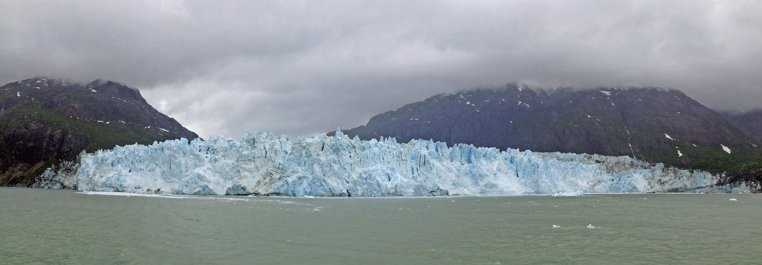The National Geographic Sea Lion entered Glacier Bay National Park after midnight and proceeded to the dock at park headquarters in Bartlett Cove. This gave an eager group of bird and photography enthusiasts an opportunity to take advantage of the abundant daylight that is available as we approach the summer solstice. Disembarking by 5:00 a.m., with soft light on distant high peaks, they trod the forest loop trail and achieved a respectable list of avian fauna and captured more pixels in a short period of time.
By 6:00 a.m. all guests were back aboard, along with National Park Service ranger/naturalist Janene, and cultural interpreter Faith, who would relate to us the dramatic story of Glacier Bay throughout our visit. The National Geographic Sea Lion departed the dock and began her voyage up-bay, to the northern extent of the waterway, which is blocked by two impressive tidewater glaciers.
“Welcome to Glacier Bay National Park,” said Janene as she addressed us at breakfast. She and Faith made short introductions and then Janene described some of the birds that roost and nest on South Marble Island to prepare us for our first stop. Using our spotting scope on the bow, we could get good looks at black-legged kittiwakes, glaucous-winged gulls, black oystercatchers, and the lovable tufted puffins. There were many piles of Steller sea lions hauled out on the rocks, ever raucous and arguing, despite their sociable behavior. A negative 2’ low tide exposed sea stars and anemones above the waterline.
As Faith and Janene distributed maps and laid out the plan for the day, we continued toward Tidal Inlet. Upon approach, a black bear was spotted up on the hillside. We practiced our technique with the spotting scope and helped each other find the distant bruin. Shortly afterward, two brown bears were seen in close proximity to each other on a wide ridge. Likely a courting pair, one was large and dark, the other much blonder in color.
At Gloomy Knob, mountain goats stood out on the precipitous calcareous rocks. We circumnavigated Composite Island, another interesting geologic feature – part granitic, part dolomite.
At last we reached the end of Tarr Inlet, where the debris-burdened Grand Pacific Glacier blocks further vessel transport. The Margerie Glacier comes down from the mountains to the west – a brilliant tributary river of ice that reaches salt water. We watched as great masses of ice calved into the sea with a splash and a roar – “white thunder.”
As we turned away, we noticed the black-legged kittiwakes nesting on the cliffs adjacent to the glacier, which provides sustenance from the depths as fish and small invertebrates are stirred up by calvings and meltwater.
Turning back, we passed the final two tidewater glaciers of the day – Lamplugh and Reid.
After more afternoon presentations and recap, we returned our guest interpreters to Bartlett Cove and the National Geographic Sea Lion guests had a chance to stretch their legs and visit the recently reconstructed humpback whale skeleton, whale 68, aka Snow, which Janene had told us about at recap. It reminded us of the magnificence and importance of this special place – Glacier Bay National Park.









